BIOL 2052 - Chemical senses
1/24
There's no tags or description
Looks like no tags are added yet.
Name | Mastery | Learn | Test | Matching | Spaced |
|---|
No study sessions yet.
25 Terms
general features of sensory systems
response to environment which are important in determining mood and behaviour
geneally: transmission —> encoding —> processing
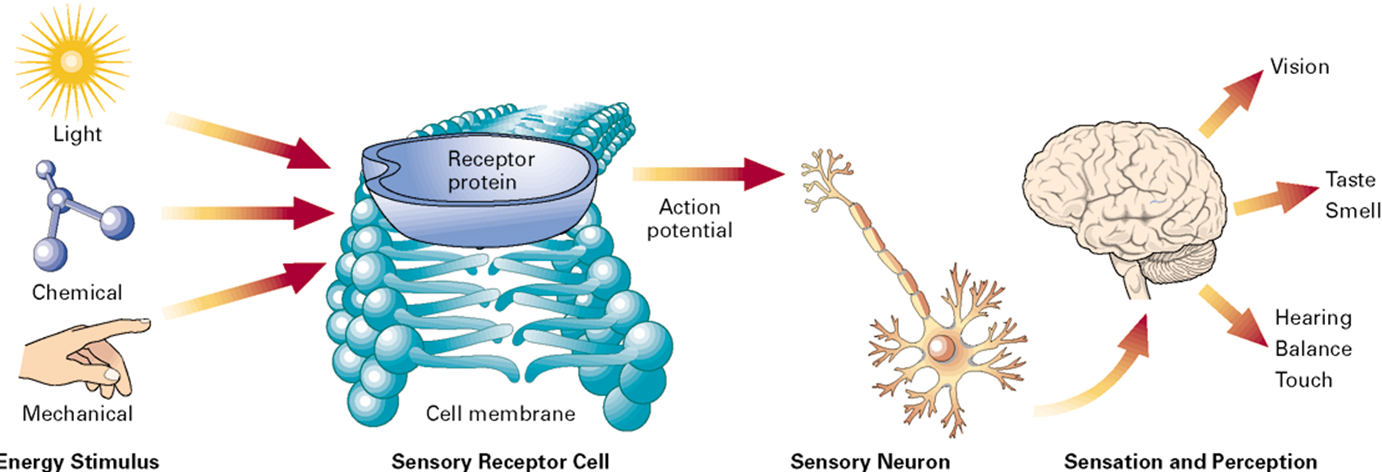
chemosensory receptors
CHEMOSENSORY RECEPTORS (exteroceptors)
receptors that generate a signal when they bind to chemicals in the external environment
chemosensation one of the oldest senses —> evolutionarily conserved
olfaction: info about airborne molecules
gustation: info about ingested substances (chemical and physical qualities)
lower organisms sensory systems good for seeking and avoiding behaviour
in higher organisms like us: chemical senses allow us to:
stimulate GI system
asses quality of food
determine if nutritionally beneficial
distance chemosensation
can sense ethanol at 2mM
2 trans-6-cis nonodenial (found in cucumbers) 0.07nM
interpretation of smell can be concentration dependent due to the patterns of neural circuitry (some in mM range, some in nM range) —> indole perfumes putrid at high concs
detection of natural odours is detection of a combination of molecules
olfaction is a reflection of the pattern of diff cells that are actiavted by the diff molecules interpreted at higher centres of the CNS
olfaction
smell comes in through the nostril —> nasal cavity
olfactory epithelium found in the nasal cavity and is a structure which houses olfactory neurons
ORN which have cilia which directly engage with the external environment
ORN travel through channels in cribiform plate —> olfactory bulb —> brain
anosmic = no ability to smell
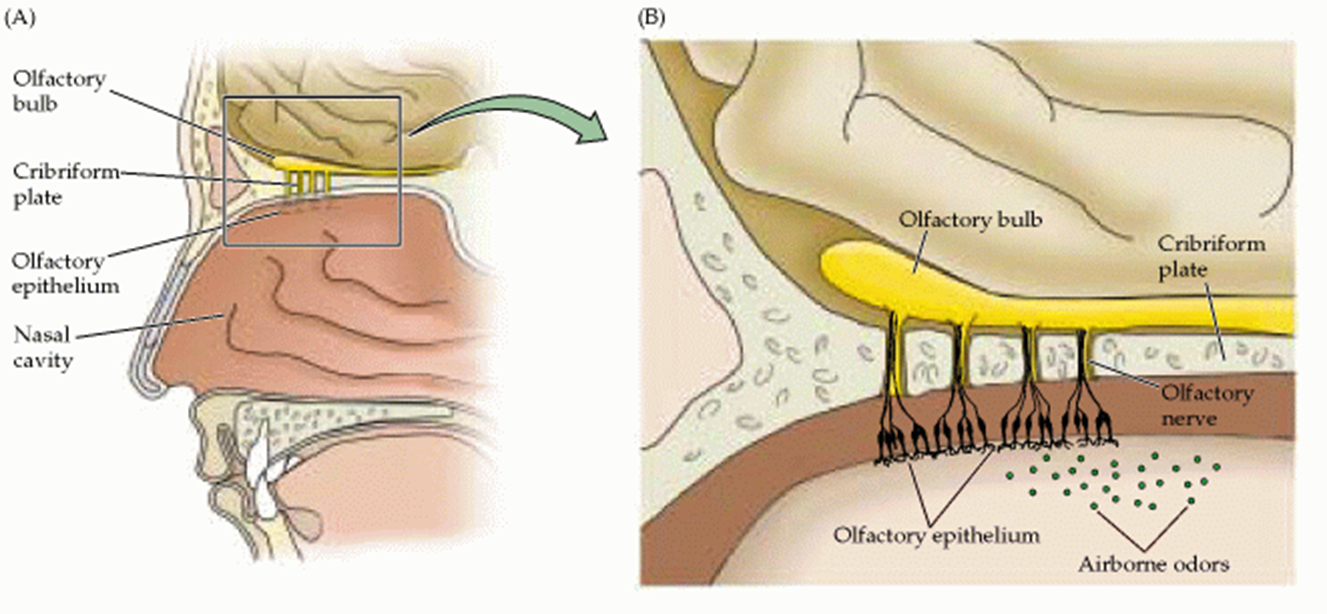
olfactory epithelium
bipolar neurons
projection to olfactory bulb at the surface of the nasal cavity where the cilia lie
unmyelinated —> not too far to travel to the brain
cilia is embedded in the mucous layer which is produced by Bowmanns gland
mucous responsible for concentrating the chemicals and bringing them in contact with cilia
these neurons are succeptible to damage
replenished by STEM cells roughly every 6-8 weeks
STEM cells located in the epithelum
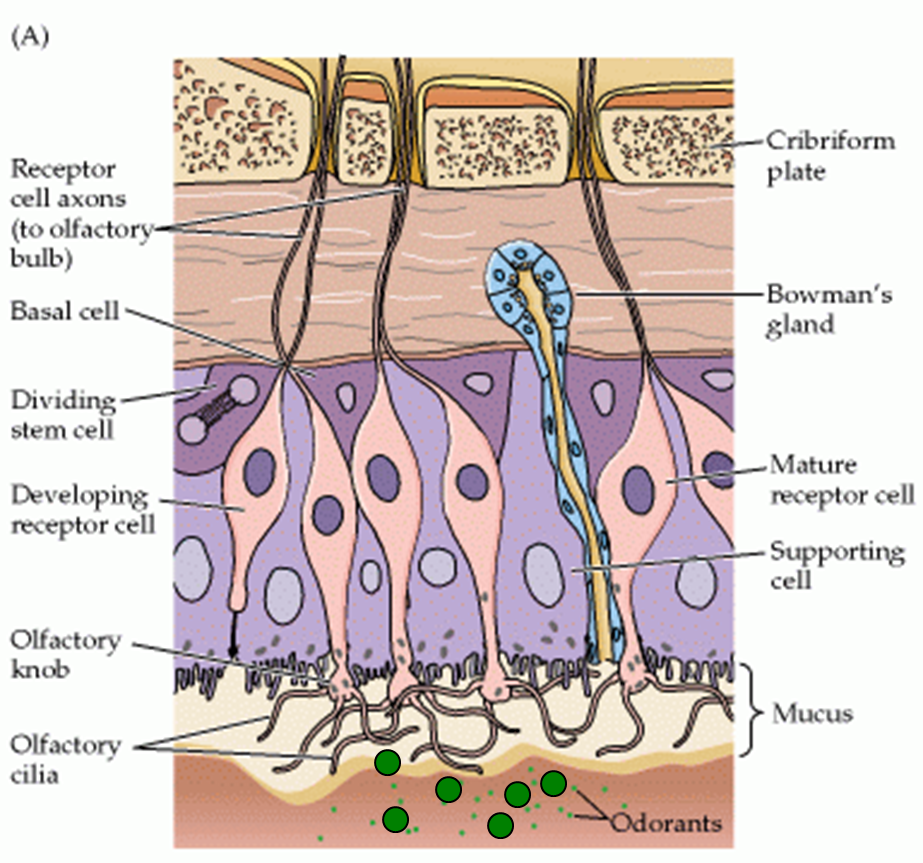
how are odours transduced
response to when the odour is applied to the cilia as opposed to the soma is a much larger response —> cilia have transduction proteins which respond to smells
transduction occurs via GPCRs —> evolutionary conserved and encoded for by 3-5% of the genome
variation in the AA structure of GPCRs allow detection of diff molecules
each neurone will express 1 GPCR
selective distribution of GPCRs in diff areas of the nasal epithelium —> 17 GPCRs in one region, M71 GPCR expressed in diff regions
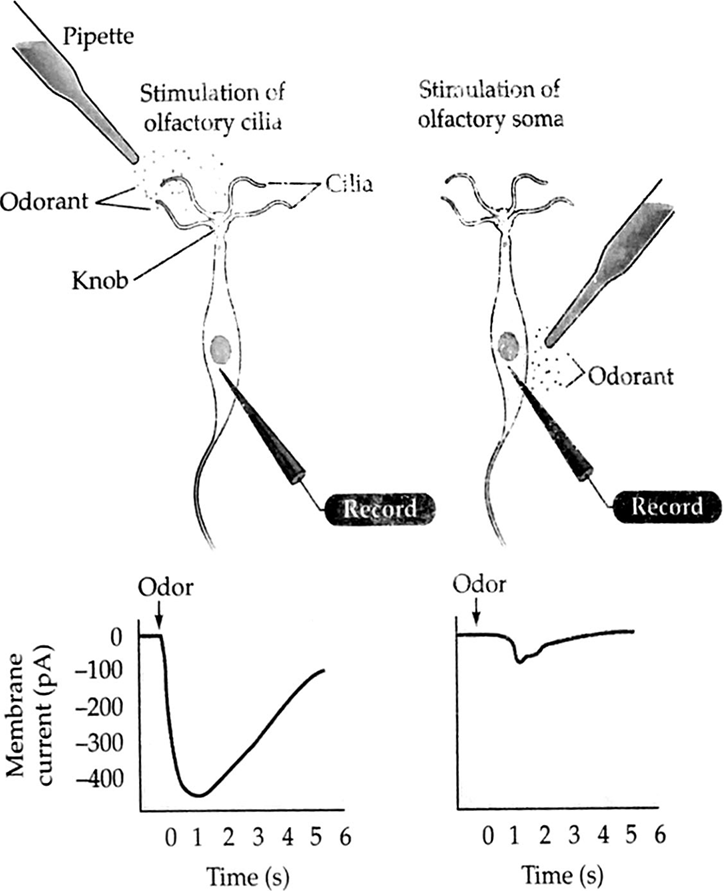
signalling pathways
G protein coupled to GPCR called Golf
activated GPCR —> activation of adenylyl cyclase —> increased cAMP
increased cAMP acts as a 2nd messenger which activated cyclic nucleotide gated channels
calcium and sodium move into the cell which causes depolarisation of the cell
some pathwys where calcium can cause chloride to move out of the cell and aid depolarisation
encoding of olfactory signals
individual ORNs are sensitive to a subset of stimuli
graohs below show the response of ORNs to smells —> neuron 1 the only one that responds to all 3, neuron 2 the only one that responds to the first one
this is how information is encoded

across fibre pattern coding
each neuron has a certain no of molecules required to activate it
this will differ for the carbon chain length and for the neuron activated which allow for further encoding
coding info across a population of neurons and depending on the output wil determine what it is (across pattern coding)
this allows us to encode natural odours to distinct patterns across a number of neurons which allows the scent to be indentified
realistically there are lots of compounds in natural odours but we only maximally respond to a few of them
E,g: indole —> at low concs it activated a certain pattern of neurons bit activates diff neurons at high concs
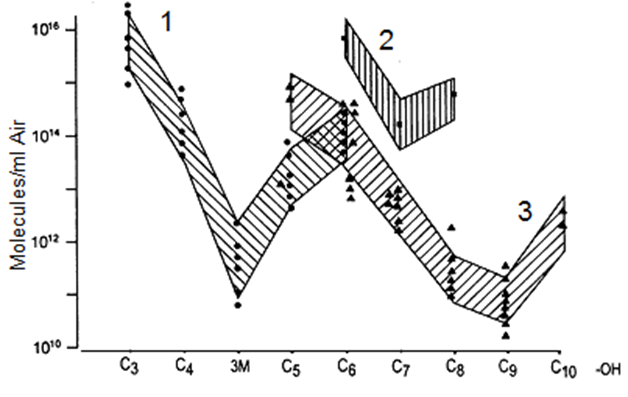
structure of the olfactory bulb
glomeruli: spherical structures below the surface of the olfacotory bulb —> regions where synapses made between the receptors and the mitral cells
mitral cells - send projections down the glomerulus which forms synapses with ORNs
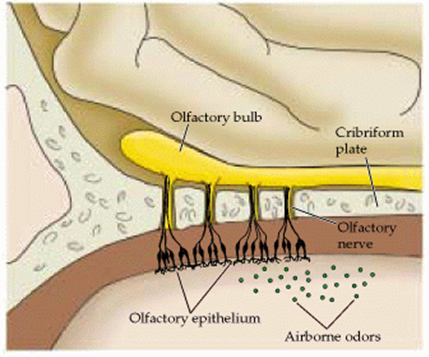

convergance and amplification
all neurons which converge to the same glomeruli express the same GPCR
bilateral pattern
single glomerulus can have dendrites from 25 mitral cells and recieve inputs from 25,000 olfactory cells
molecular endocoding and electrical patterns
signals from teh olfactory bulb —> accessory nuclei
the relationship between one type of odourant neuron and one glomeruli enables specific regions of the olfactory bulb to respond to diff chemicals
diff odours and chemicals will activate a unique spatial pattern in the olfactory bulb depending on their chemical composition
chemically distinct single odourants will maximally activate one or only a few glomeruli
processing olfactory signals
signals from the olfactory system travel through cranial nerve 1 —> olfactory bulb where they project to cortical structures
piriform cortex (has no clear pattern of organisation like the sensory cortex)
olfactory tubercule
amygdala
entorhinal cortex
signals from there —> other structure like the hippocampus
this is how smell can impact mood or trigger memory
its different to other sensory systems as it doesn’t go straight to the thalamus —> goes via the olfactory bulb targets and olfactory cortex
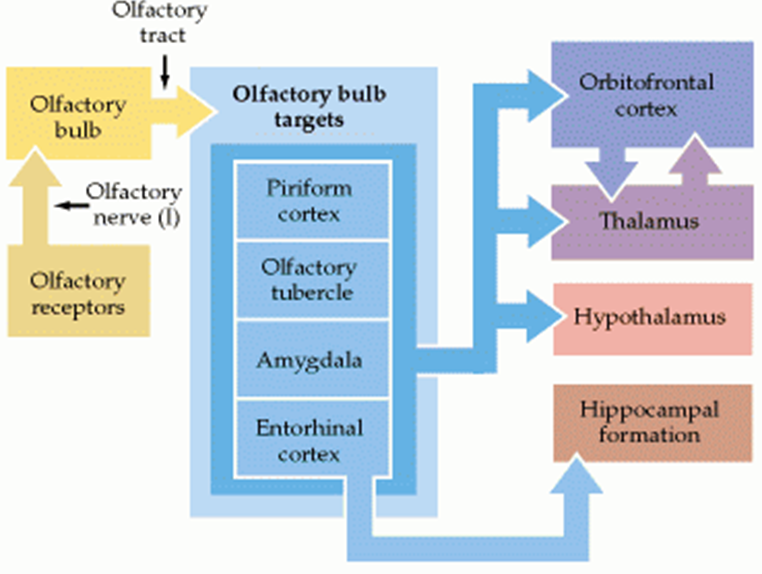

gustation
is an example of contact chemo sensation —> must come into contact in order to taste something
tongue is the main sense organ
4 types of papillae (invaginations) on the tongue with different number of taste buds (house the gustatory receptors)
circumvallate located at the back of the tongue —> 250 taste buds
foliate at the sides —> organised into parallel ridges with 600 taste buds
fungiform at the front —> 3 taste buds
filiform in the middle
apart from filiform all have associated taste
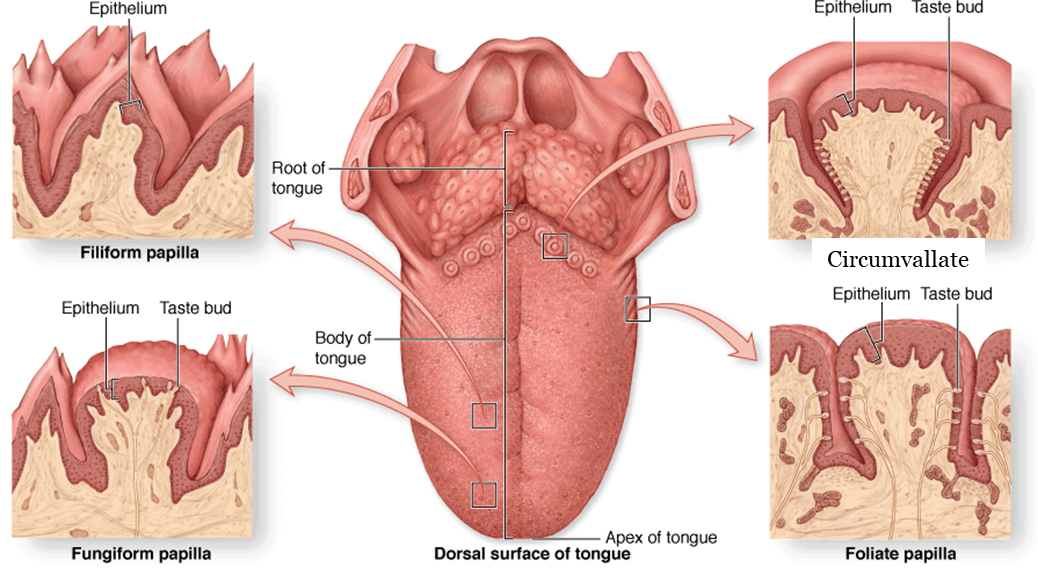
circumvalate papillae
troughs fed by serous gland which secretes saliva
taste buds at the base of the trough
saliva breaks down food in the mouth and concentrates down the moleules for taste buds
5 basic tastes
bitter (caffiene, nicotine)
sour (actetic acid)
sweet (glucose, fructose)
salt (NaCl)
umami (Msg)
all in the millimolar range —> less sensitive than smell
sensitive to bitter, can respond at low concentrations
less sensitive to glucose —> nutritionally beneficial so drives our sense to consume more of it
sensitivity range: bitter>acid> salt> sweet
certain regions of the tongue are more sensitive than others —> driven by expression levels of receptors
can be advantageous —> bitter at the back —> drives a pathway to spit out the food
some selectovity of regions where certain tastes initiate activity
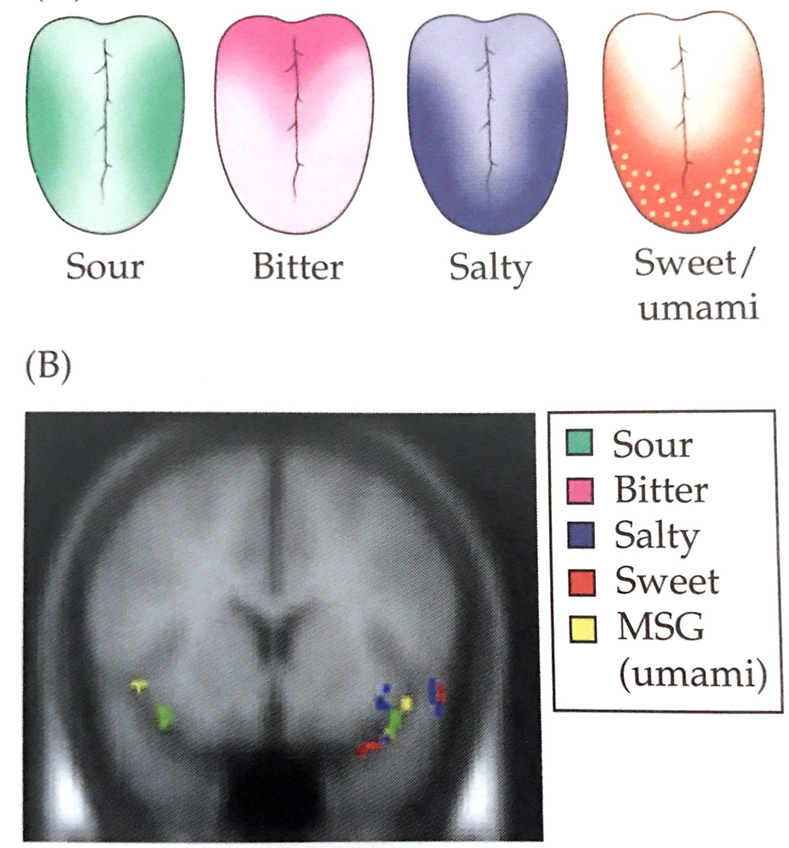
taste buds
a single taste bud can contain up to 50 specialised epithelial cells which convert checmical —> electrical signals
the tips of the cells have microvilli which increase the surface area and come together at the taste pore
receptors are localised in the microvilli
olfactory receptors neurones are bipolar neurons, however, gustatory system receptor cells release neurotransmitters whcih cause signalling in the afferent neurons
taste cells are subject to damage - require basal cells to regenerate them
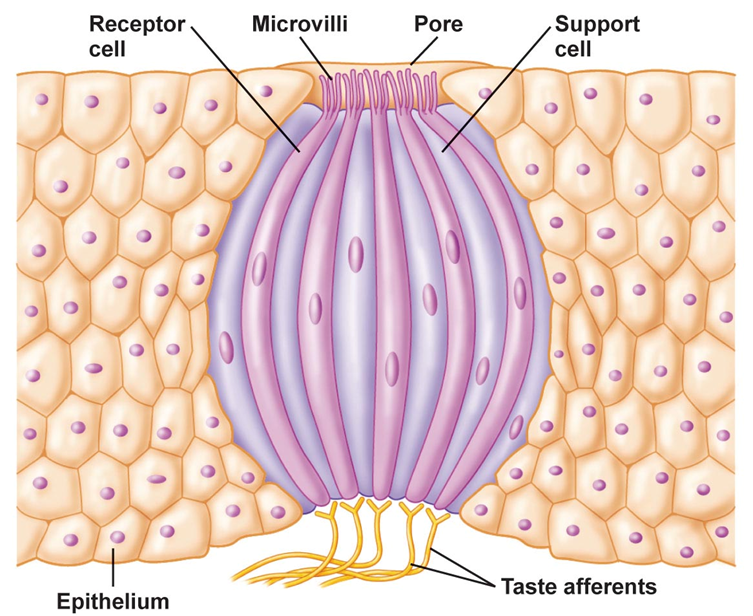
transduction in taste cells
apiccal domain where receptors expressed
ion channels and GPCR depending on taste
salt/sour - ion channel
sweet/bitter/umami - GPCR
influx of Na leads to opening of voltage gated Ca channels and influx of Ca which causes the release of serotonin and ATP
signals are returned via 3 cranial nerves
vagus (10)
facial (7)
glossopharangeal (9)
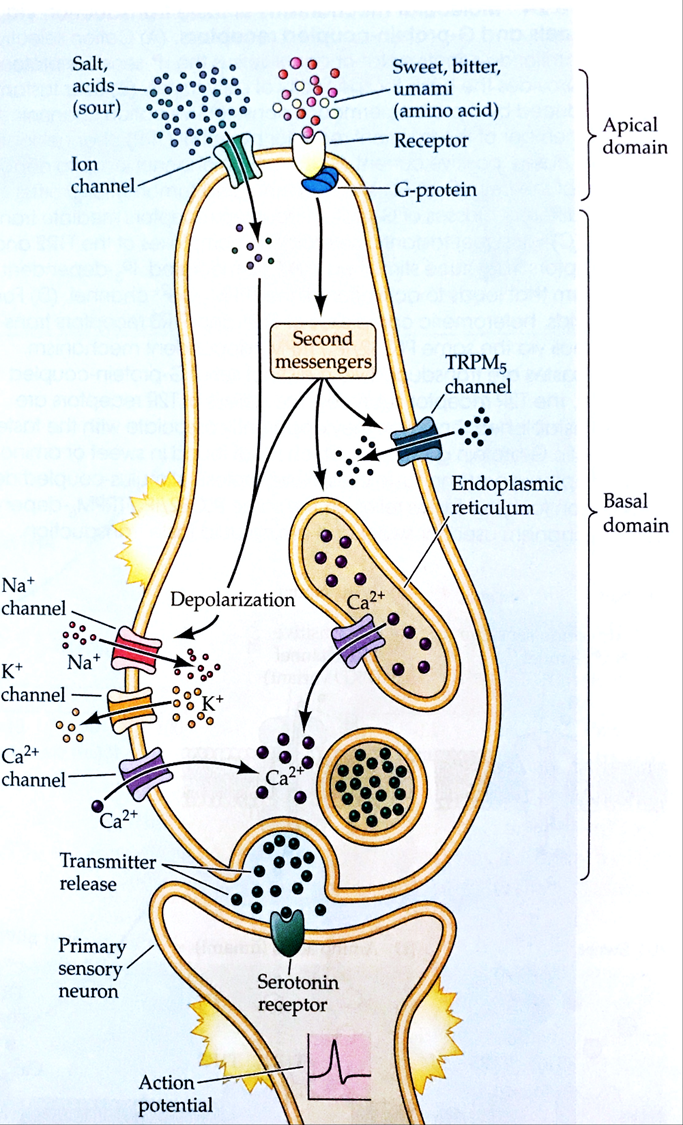
salt/sour sensing
SALT
Na ions move down their conc grad through amilloride sensitive ion channels
ACIDS
H+ sensitive ion channels
H+ ions block K+ channels which prevents K+ from leaving and results in depolarisation which opens voltage gated Ca2+ channels
direct depolarisation results in no second messenger
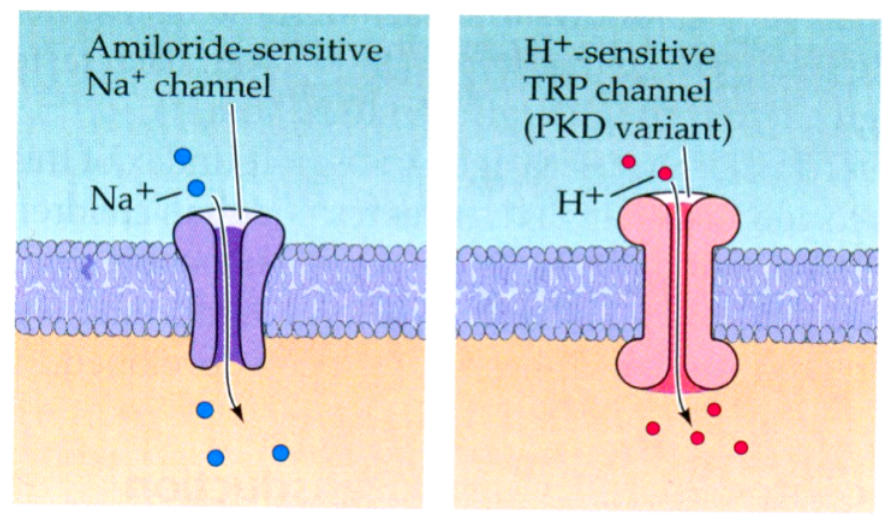
sweet/umami sensing
T1R heterodimers
lots of variation in AAs
ligands that bind depends on the heterodimer
SWEET
T1R2/T1R3 signals through G protein which activates PLCB2 which activates IP3
engages with eR receptor and release of Ca
activation of TRPM5 Ca ion channel —> depolarisation
this is an indirect response to depolarisation
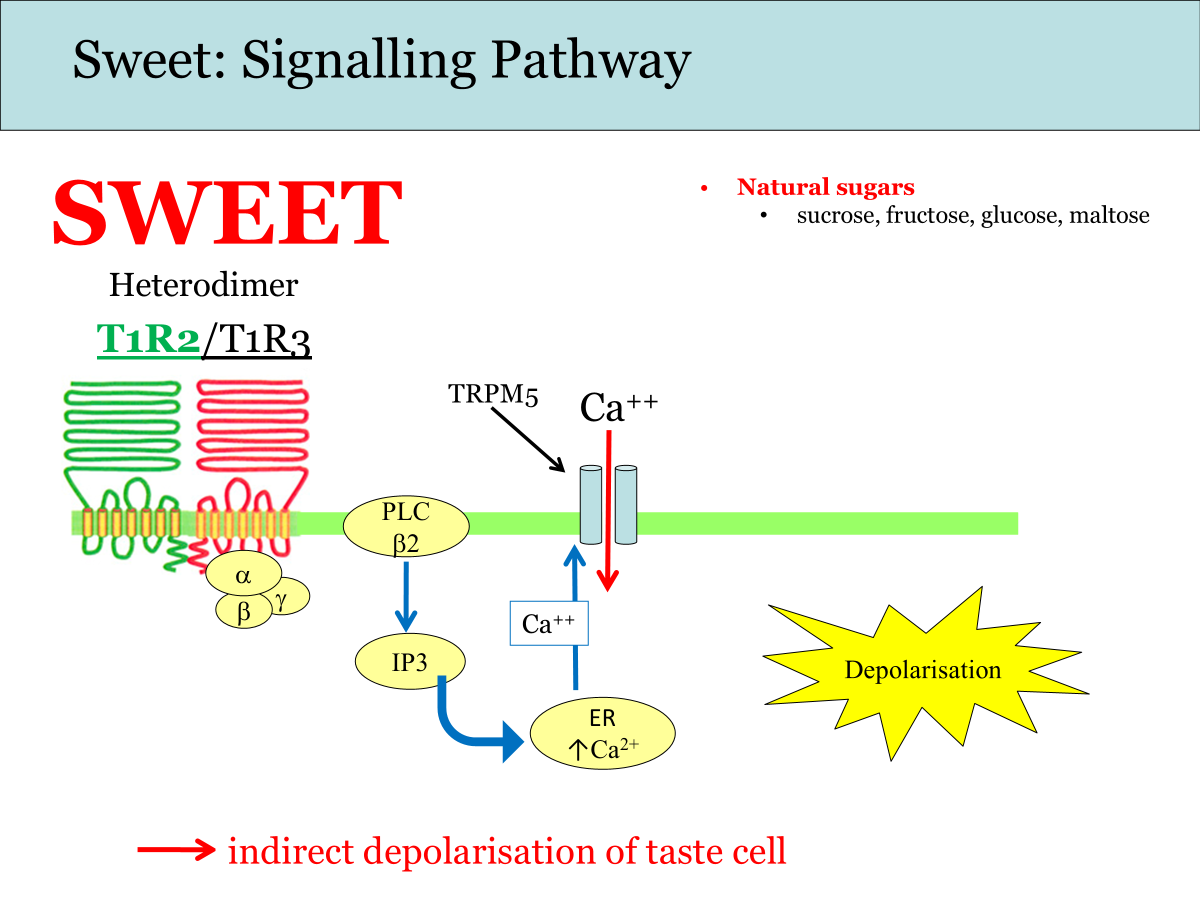
UMAMI
diff heterodimer - T1R1/T1R3
same pathway as sweet
has another signalling pathway of the GluR4 - also an mGluR4 receptor in brain with a longer N terminus
inhibits cAMP signalling (diff pathway)
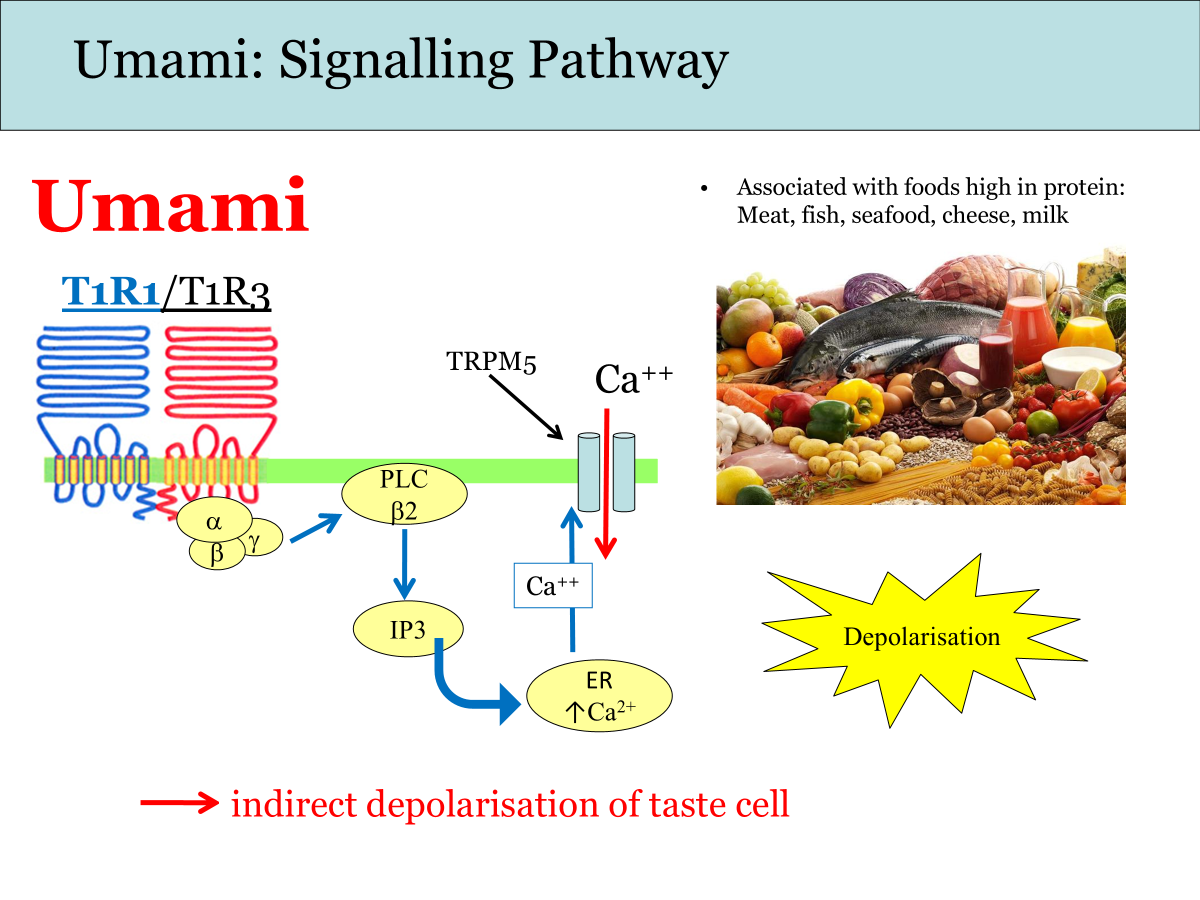

bitter sensing
T2R receptors (GPCRs)
25% of population dont respond to it (phenylthiocarbamide)
diff populations of taste cells as T1R
shorter N terminal
signalling via IP3/Trpm5 pathway
specific to G protein alpha gusducin, only expressed in bitter taste cells
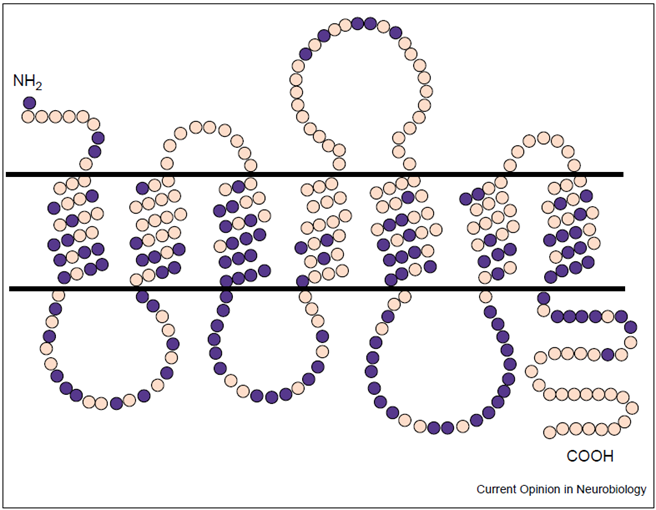
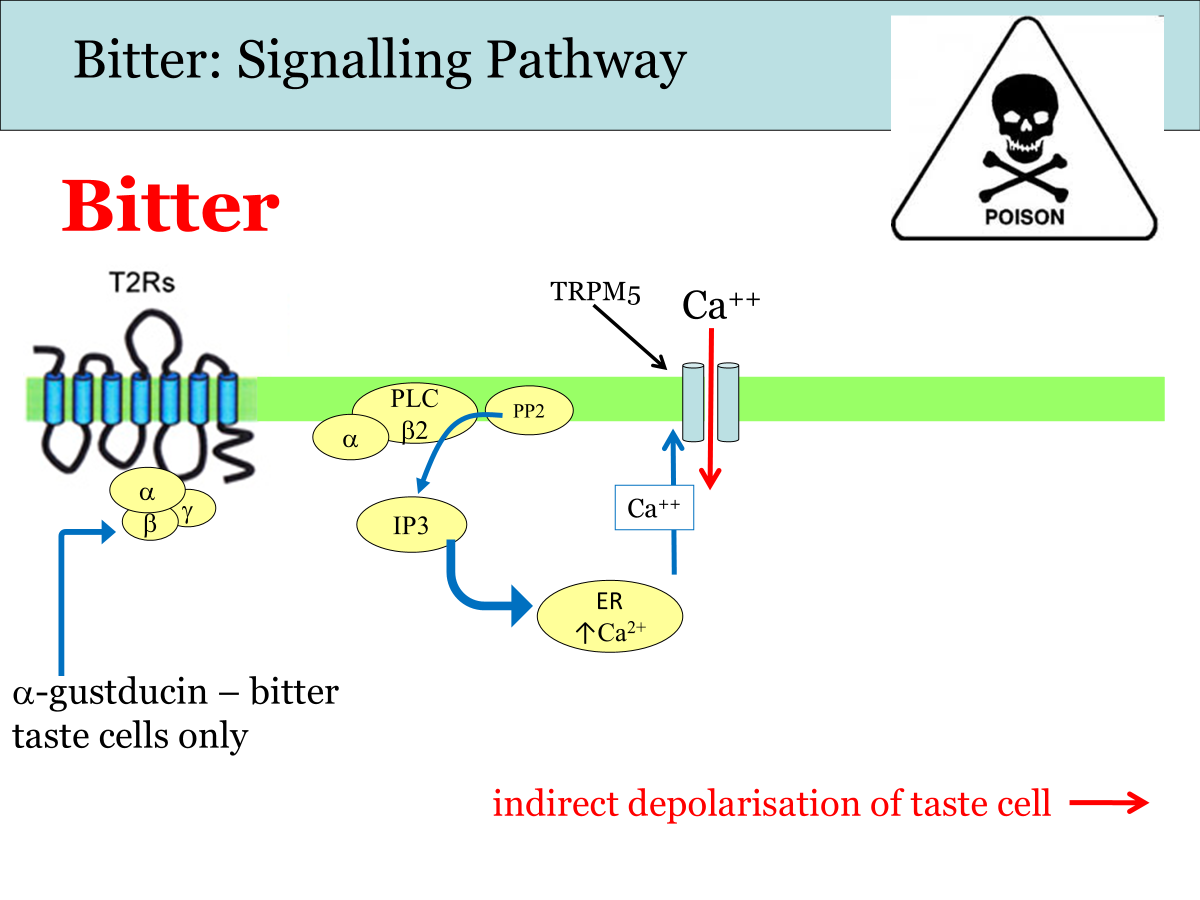
downstream signalling
determined by rodent knockouts (of the TrpM5 Ca2+ ion channel)
sweet and umami have a positive correlation as conc increases quinine/bitter has a positive response
TrpM5 have a phospholipase B important signalling for sweet umami and bitter


processing
3 cranial nerves return signals from diff parts of the brain
7: tongue pallate —>nucleus of solitary tract (gustatory nucleus)
9: back of the tongue —> medial region of the gustatory nucleus
10: eppiglottis/oesophagus —> caudal region of the gustatory nucleus
these are the 1st order neurons
medulla —> thalamus and other parts of the brain
the nucleus of the solitary tract intergrates visceral info about gut motility (as gut innervated by vagus nerve)
drives gustatory visceral reflex arc —> enables you to be sick if you consume something bad tasting
from the gustatory nucleus in the medulla the ventral posterior medial nucleus of the thalamus
signals from the thalamus go to:
amygdala
orbitofrontal cortex - 2ndary taste centre
insula

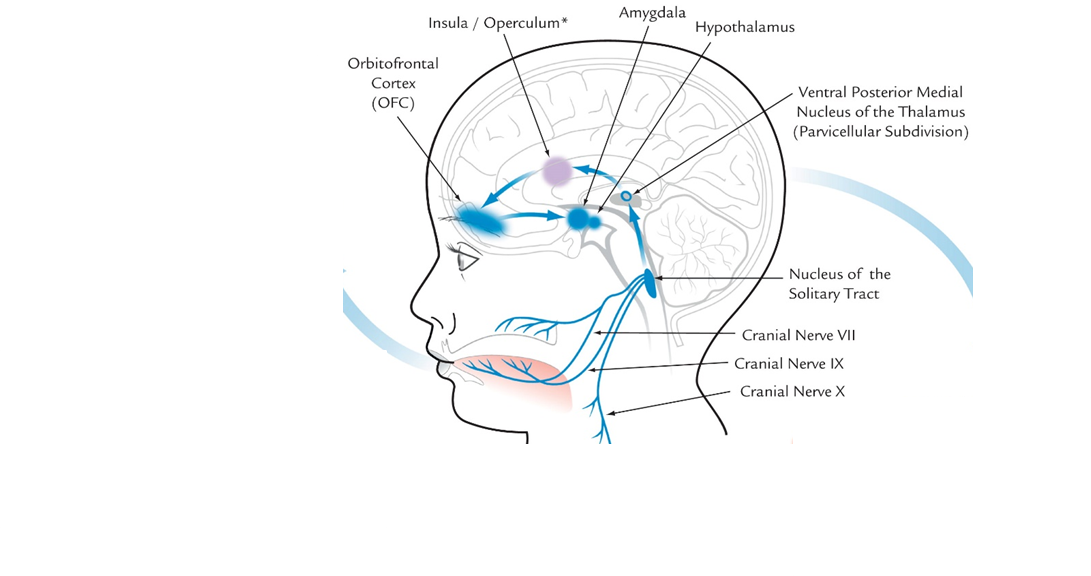
mapping of gustatory cues
some mapping that takes place
some regions particularly sensitive to NaCl compared to sweet/bitter
labelled line coding
gustatory system uses labelled line coding
in mice, experiments undergone where a wild type and a T2R knockout exposed to a taste and response recorded
the response in t2R knockout much lower than wild type
T2R gene in knockout turned back on to see if wild type response cen be rescued
only in mice exposed to glutamate is response restored
this means that only cells which express T2R receptors only respond to bitter taste
orbitofrontal cortex gives our overall perception of food
involved in satiation - as we become satiated, signalling in orbital cortex decreases
